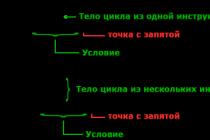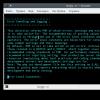Nowadays, the prevailing high level automation, and this is reflected in almost all spheres of human activity. In connection with such relevance of technical progress, digital cartography arose, which is a computer processing and analysis of cartographic information. At the moment, it is digital cartography that is the most popular in its scientific field, since now the creation of any cartographic images is performed on a computer.
Digital cartography cannot be called a separate discipline or section. This is most likely an effective tool that allows you to conveniently and quickly process cartographic data using a PC. However, the influence digital cartography on science is really strong, and this method terrain mapping has fundamentally changed the principle of territory visualization.
Let's compare digital cartography with the old way of creating maps. In ancient times, cartographers spent days and nights at the map, drawing each element in ink. Such work was very painstaking, and the labor costs were simply unjustified. Now the technology for creating maps has changed significantly, and now the computer does all the routine work, and much faster. During the processing of cartographic information on a PC, special automated systems, which have a lot of functionality, consisting of the tools needed to create maps. Due to their flexibility, automated mapping systems provide a lot of opportunities for modern cartographers, which really simplify and improve the process of illustrating the area.
You can count from one thousand nine hundred and fifty-seven. This year, the Massachusetts Institute of Technology (USA) produced the first digital elevation and terrain model of the map, which was later used to design highways. This indicates that in cartography since the middle of the twentieth century, new technological mapping and mapping processes and methods have begun to develop, which have been improved to this day. The main areas and trends of improvement in them can be identified:
- technological (electronic) methods of creating maps;
- digital ways of organizing banks and databases;
- geoinformation mapping technologies;
- formation of maps in computer networks;
- development of virtual mapping.
For a more efficient application of scientific and technological processes for the development of cartography, the fastest delivery of the products created by it to end user. Then they will be promptly used by consumers to solve their specific tasks. In modern realities, all scientific and production branches, including digital cartography, are guided by the satisfaction of such requests and needs of society. Thus, with the help of digital technologies, cartography is transformed from cognitive and simple means of orientation into mathematical tools and methods of design, organization, management and planning. It is already obvious that technological progress has influenced the ways in which maps are used, of which we highlight the following:
- communication methods;
- spatial information;
- system decision making.
The essence of digital cartography
Digital cartography can be represented in three or even four substantive forms:
- section of cartographic science;
- manufacturing industry;
- new technology.
- visualization tool for images of cartographic products.
First of all, as a branch of cartographic science, digital cartography is engaged in the study and display of the spatial location of various objects of society, all kinds of natural phenomena, their digital modeling and relationships.
With the application and use of automated manufacturing processes, new computer technologies and a diverse visual range of images, digital cartography is particularly popular with both consumers and professionals. The production of cartographic products, as an industrial production, is a multifunctional technological process using modern technologies and in demand as electronic product.
It is worth remembering how maps were previously built. Entire full-time cartographic groups and thematic parties were created, the services of which arose in production. All received shooting information was recorded with ink on tracing paper or a denser basis. Great labor intensity, significant time costs and scrupulousness in the entire mapping process made the process slow. Now all this is being replaced by computer technology, with the possibility of faster and more accurate execution of projects, convenience in updating and editing maps.
Benefits of Digital Mapping
Comparing all the previous and present possibilities of various mapping methods, including the economic component of market efficiency, the following advantages of digital cartography can be distinguished:
- transmission of accurate information about the object, which practically excludes the possibility of errors due to the use of computer automation in calculations;
- speed of processing and obtaining the final result with higher labor productivity;
- a more economical way to create maps with less labor;
- the possibility and convenience of both editing and periodic updating of maps on the same mathematical and geodetic basis.
It should also be noted that digital cartography is increasingly occupying a place in the global information flow, penetrating into various areas of interesting modern life on the planet and gaining significant segments of users of its products, thereby creating an increased demand. This situation occurs as it develops:
- new (computer) technologies for cartographic and geoinformation systems;
- new (space) methods of geodetic spatial positioning and determining the location of all objects;
- improvement of map making, increasing the accuracy and speed of mastering new demanded cartographic products.
Types of digital mapping production
Digital cartographic production, in order to obtain certain results in its modern form, is engaged in the following production processes:
- development of digital standard maps and other cartographic materials necessary for this in the form of information arrays of the entire set of objects;
- creation of thematic maps using existing digital mathematical and cartographic bases;
- maintenance of digital databases of various information, including state borders;
- digital mapping based on satellite and aerial photographs;
- digital application of the construction of topographic maps.
Digital Cartography Manufacturing Processes
Digital cartography is a complex technological product that represents cartographic production, consisting of the following production processes:
- editorial preparatory period for compiling a digital map;
- input control of raw materials;
- classification of objects of prepared documentation;
- object encodings;
- descriptions of digital map objects;
- map editing;
- quality control;
- updates;
- conversion to exchange format;
- conversion to a given format;
- digitization of map materials;
- map vectorization;
- automation of cartographic generalization;
- summary of digital maps;
- card summary control;
- transfer to the Fund of topographic maps.
Digital maps can be directly perceived by a person when visualizing electronic maps (on video screens) and computer maps (on a solid basis), and can be used as a source of information in machine calculations without visualization in the form of an image.
Digital maps serve as the basis for the production of conventional paper and computer maps on a solid substrate.
Creation
Digital maps are created in the following ways or a combination of them (in fact, methods for collecting spatial information):
Digitization (digitization) of traditional analogue cartographic products (for example, paper maps);
photogrammetric processing of remote sensing data;
Field survey (for example, geodetic tacheometric survey or survey using global satellite positioning systems instruments);
· cameral processing of data from field surveys and other methods.
Storage and transmission methods
Since the models describing space (digital maps) are very non-trivial (unlike, for example, raster images), specialized databases (DB, see spatial database) are often used for their storage, rather than single files of a given format.
To exchange digital cards between different information systems, special exchange formats are used. These can be either popular formats of some software (software) manufacturers (for example, DXF, MIF, SHP, etc.), which have become a de facto standard, or international standards (for example, such a standard of the Open Geospatial Consortium (OGC) like GML).
Cartography
Cartography (from the Greek χάρτης - papyrus paper, and γράφειν - to draw) is the science of researching, modeling and displaying the spatial arrangement, combination and interconnection of objects, natural phenomena and society. In a broader interpretation, cartography includes technology and production activities.
The objects of cartography are the Earth, celestial bodies, the starry sky and the Universe. The most popular fruits of cartography are figurative-sign models of space in the form of: flat maps, relief and volumetric maps, globes. They can be presented on solid, flat or voluminous materials (paper, plastic) or as an image on a video monitor.
Sections of cartography
Mathematical cartography
Mathematical cartography is the study of ways to display the surface of the Earth on a plane. Since the surface of the Earth (approximately spherical, for which the concept of the earth's spheroid is often used) has a certain curvature that is not equal to infinity, it cannot be displayed on a plane with the preservation of all spatial relationships simultaneously: angles between directions, distances and areas. You can save only some of these ratios. An important concept in mathematical cartography is cartographic projection, a function that specifies the transformation of the spheroid coordinates of a point (that is, coordinates on the earth's spheroid, expressed in angular measure) into flat rectangular coordinates in one or another cartographic projection (in other words, into a map sheet that can be spread out in front of you on the surface of the table). Another significant branch of mathematical cartography is cartometry, which allows using map data to measure distances, angles and areas on the real surface of the Earth.
Drawing up and designing maps
Drawing up and designing maps is a field of cartography, a field of technical design that studies the most adequate ways of displaying cartographic information. This area of cartography is closely interconnected with the psychology of perception, semiotics and similar humanitarian aspects.
Since the maps display information related to a wide variety of sciences, there are also such sections of cartography as historical cartography, geological cartography, economic cartography, soil cartography, and others. These sections relate to cartography only as a method; in terms of content, they relate to the corresponding sciences.
Digital cartography
Digital (computer) cartography is not so much an independent section of cartography as its tool, due to the current level of technology development. For example, without canceling the methods of recalculating coordinates when displaying the Earth's surface on a plane (it is studied in such a fundamental section as mathematical cartography), digital cartography has changed the ways of visualizing cartographic works (it is studied in the section "Compilation and design of maps").
So, if earlier the author's original map was drawn in ink, today it is drawn on the computer monitor screen. To do this, use Automated Cartographic Systems (ACS), created on the basis of a special class of software (SW). For example, GeoMedia, Intergraph MGE, ESRI ArcGIS, EasyTrace, Panorama, Mapinfo, etc.
At the same time, ACS and Geographic Information Systems (GIS) should not be confused, since their tasks are different. However, in practice, the same set of software is an integrated package used to build both ACN and GIS (bright examples are ArcGIS, GeoMedia and MGE).
Creation of electronic maps (contours) of fields.
For the effective management of an agricultural enterprise, it will not be superfluous to know exactly what acreage you have. It is not uncommon for managers and agronomists of farms to know only approximately the size of their fields, which negatively affects the accuracy of calculating the necessary fertilizers and calculating the yield. Using a GPS receiver, a field computer and special software (software), you can get electronic maps (contours) of fields with centimeter accuracy!
Resource-saving technologies, including precision agriculture, involve working with electronic field maps. This is the geoinformation base on the basis of which almost all agrotechnical operations in precision farming are carried out. For example, one of the most complex agrotechnical operations of precision farming - differentiated application of mineral fertilizers is based on maps of the distribution of nutrients (N, P, K, Humus, ph) across the field. For this, an agrochemical survey of farmland is also carried out.
But even if electronic field maps are not used for the further application of precision farming technologies, the benefits of creating such maps are obvious. Knowing the exact areas of your fields and the distances between them, you can more efficiently and rationally:
1. Calculate the amount of necessary fertilizers and agrochemicals, as well as seed material
2. Take into account the resulting yield
3. Calculate the planned consumption of fuel and lubricants
4. Keep annual records of sown areas with high accuracy for each crop
5. Keep a history of fields (crop rotations)
6. If necessary, prepare visual reports of high accuracy (map printing)
The creation of field contours is carried out using a GPS receiver, a field computer and software combined into a single software and hardware complex. In the "polygon" mode, it is necessary to go around or bypass the field along its border and save the resulting contour. When saving, you can specify the name of the field and other necessary attributes and notes. After saving the contour, we will know the exact area of the field.
The software also allows you to apply other geoinformation information: lines and points. Lines can be operated when marking working areas in the fields. For example, if you already have electronic maps of your fields for the last year and you only need to fix the placement of crops in the fields this year, then there is no need to re-outline the fields. It is only necessary to draw demarcation lines between crops, and then only if two or more crops are cultivated on the same field.
Points are used to map field features such as pillars, large rocks, and so on.
All received geoinformation from the software and hardware complex must be transferred to a stationary computer for further analysis and use in calculations and in making management decisions. Geoinformation software (GIS) must also be installed on a stationary computer, which will allow you to work correctly with the information received in the fields. For these purposes, we recommend using the MapInfo © program.
In principle, you can use any GIS system that works with the .SHP (Shape) format. Almost all GIS systems can work correctly with this format. However, MapInfo © is, in our opinion, the best choice for accounting of sown areas and maintaining the history of fields. in mapinfo. You can create thematic maps, overlay the contours of your fields on satellite imagery and aerial photographs, as well as digitized topographic maps. Also in MapInfo there is a handy tool for measuring distances (for example, to measure the distance from the garage to the field).
"...Digital cartography: a section of cartography covering the theory and practice of creating and using digital cartographic products..."
Source:
"GOST 28441-99. Digital cartography. Terms and definitions"
(put into effect by the Decree of the State Standard of the Russian Federation of October 23, 1999 N 423-st)
- - the science of geography maps grew from the measurement of the Earth, from those requests and needs that arose as they became acquainted with other lands, from cosmological. speculation...
Ancient world. encyclopedic Dictionary
- - The science of geography. maps grew from the measurement of the Earth, from those requests and needs that arose as they got to know other lands, from cosmological. speculation...
Dictionary of antiquity
- - Already at first glance, striking external differences medieval maps from maps of modern times. The Middle Ages did not know topographic surveys...
Dictionary of Medieval Culture
- - cartography is the science of displaying and understanding natural and socio-economic geosystems through maps as models ...
Geographic Encyclopedia
- - the science of geographical maps, methods of their compilation and use ...
Geological Encyclopedia
- - ".....
Official terminology
- - the science of geographical maps, the methods of their creation and use. This most common definition of K. reflects its technical aspects ...
Great Soviet Encyclopedia
- - the science of geographical maps, methods of their creation and use ...
Modern Encyclopedia
- - a science that includes theory, methodology and techniques for creating and using geographical maps, globes, maps of the moon, planets, starry sky, etc. It is divided into cartography, mathematical cartography, ...
Big encyclopedic dictionary
- - R., D., Pr....
Spelling Dictionary of the Russian Language
- - cartography / fia,...
merged. Separately. Through a hyphen. Dictionary-reference
- - CARTOGRAPHY, -and, wives. The Science of Mapping and Mapping...
Explanatory dictionary of Ozhegov
- - CARTOGRAPHY, cartography, pl. no, female . The doctrine of the methods of compiling geographical maps. || Same as mapping...
Explanatory Dictionary of Ushakov
- - cartography 1. A scientific discipline that studies the methods of creating and using map I. 2...
Explanatory Dictionary of Efremova
- - cartograph "...
Russian spelling dictionary
- - CARTOGRAPHY and, well. cartography f. The science of making maps. BAS-1. || Same as mapping. BAS-1. - Lex. Toll 1864: ...
Historical Dictionary of Gallicisms of the Russian Language
"Digital cartography" in books
15.1. Dream Cartography
From the book Dream Workshop of Ravenna. Step 1-2 author Balaban AlexanderDigital puzzle
From the book The most difficult puzzles from vintage magazines author Townsend Charles BarryDigital puzzle This puzzle was invented by the famous talking rhinoceros Rupert. Arrange the four numbers - 2,3,4 and 5 - and the signs "+" and "=" in such a way that you get an arithmetic example. This puzzle is only simple at first
Cartography
authorCartography Geographic maps are one of the main languages of geography. This language, as a means of expressing people's ideas about their geographic environment and transmitting spatial information, is more ancient than any form of writing. known
ancient cartography
From the book Another History of Science. From Aristotle to Newton author Kalyuzhny Dmitry VitalievichAncient cartography Strabo was absolutely right when he wrote that the most accurate image of the earth's surface is a large globe. But since the official history incorrectly dates the time of his life, it turns out that this idea was implemented in
CARTOGRAPHY CERTIFIES
From the author's bookCARTOGRAPHY CONFIRMS According to modern historiography, Russia appears only in the 8th century. n. e. This goes against what I am arguing in this monograph. A serious argument of my opponents is the assertion that if Russia (Rus) existed before this
Digital camera
From the book 100 great wonders of technology author Mussky Sergey AnatolievichDigital camera In 1989, the Svema factory produced the last batch of 8 mm amateur film, five years ago the last laboratory for developing this film was closed, and a little later all the necessary chemicals disappeared from the sale ... So, on our
Cartography
TSBHistorical cartography
From the book Big Soviet Encyclopedia(KA) author TSB"Geodesy and Cartography"
From the book Great Soviet Encyclopedia (GE) of the author TSBMathematical cartography
From the book Great Soviet Encyclopedia (MA) of the author TSBeconomic cartography
From the book Great Soviet Encyclopedia (EC) of the author TSBdigital system
From the book Great Soviet Encyclopedia (CI) of the author TSBDigital video camera
From the book A Thousand and One Advice on Home and Life author Polivalina Lyubov AlexandrovnaDigital video camera As already mentioned, digital video cameras are more expensive than analog ones, and therefore are not always available to the average consumer. Recording is done in Digital-8 and MiniDV formats on a DV cassette. They have all the same functions that are used in analog cameras.
Digital technology
From the book Guide to the magazine "Radio" 1981-2009 author Tereshchenko DmitryDigital Technique Counter for electronic clockKorotaev G.1981, No. 1, p. 46. Music box Pauline A. 1981, No. 2, p. 47. Digital exposure meter Psurtsev V. 1981, no. 3, p. 23. Digital exposure meter Psurtsev V. 1981, no. 4, p. 30. Stopwatch-timer from B3-23Dlya national economy and lifeZaltsman Yu.1981, No. 5, p.
Digital signature.
From the book PGP: Encoding and Encrypting Public Key Information. the author Levin MaximDigital signature. A huge advantage of public cryptography is also the ability to use digital signature, which allow the recipient of the message to verify the identity of the sender of the message, as well as the integrity (fidelity) of the received
Digital Cartography and GIS
In the last decade, cartography has been undergoing a period of profound changes and technological innovations caused by the informatization of science, industry and society as a whole. There was a need to revise and redefine many concepts of this scientific discipline. For example, back in 1987, two working groups on cartographic definitions and concepts were established within the International Cartographic Association. Moreover, one of the main questions to be studied and resolved was the question of whether it is possible to define cartography without the concept of "map" and whether GIS or its elements should be included in this definition. In 1989. The working group proposed the following definition: "Cartography is the organization and communication of geographically referenced information in graphical or digital form; it may include all stages from collection to display and use of data." The concept of "map" is not included in this definition, but it is proposed to consider it separately as a "holistic (i.e., holistic, structural) display and mental abstraction of geographical reality, intended for one or more purposes and transforming the corresponding geographical data into works presented in visual, digital or tactile forms".
The above definitions caused a wide discussion among cartographers, and as a result, a Alternative option definition of cartography, in which it is considered as "the organization, display, communication and use of spatially coordinated information presented in graphical, digital and tactile forms; may include all stages from the collection of data to their use in the creation of maps or other spatial information documents".
According to most modern cartographers, the technological aspects of cartography are not the main ones in the era of computer science, and all definitions of cartography through technology are erroneous. Cartography remains an applied, predominantly visual discipline in which great importance have communication aspects. The assessment of computer maps in the sense of their similarity, indistinguishability from manually created maps is also erroneous. The real value of GIS technology lies precisely in the possibility of creating works of a new type. With all this, the main task of cartography remains the knowledge of the real world, and here it is very difficult to separate the form (cartographic display) from the content (reflected reality). Progress geoinformation technologies only increased the range of data to be mapped, expanded the range of scientific disciplines in need of cartography. Screen (display) maps and electronic atlases, which are now becoming part of national cartographic programs in many countries, only strengthen the links between cartography and computer graphics and GIS, without changing, however, the essence of mapping.
It should be noted that digital cartography in genetic terms is not a direct continuation of traditional (paper) cartography. It has evolved in the course of the overall development of GIS software and is therefore often viewed as a minor GIS component that, unlike GIS software, does not require a large investment of effort and resources. So, an untrained user with the help of existing GIS software after a few days of training can already create a simple digital map, but even in a month he is not able to create a workable GIS software. On the other hand, as cartographers note, due to the apparent ease and simplicity, digital cartography is underestimated with all the ensuing consequences.
Digital cartography has taken on a life of its own, and its association with traditional cartography is often seen as completely redundant. As you know, the creation of a traditional paper map requires rather complex equipment, as well as a team of experienced specialists (cartographers-designers) who create and edit maps and perform routine work on processing primary material. This is a technically and technologically very complex and time-consuming process. On the other hand, to create a digital map, you only need Personal Computer, external devices, software and the original (generally paper) map. In other words, any user gets the opportunity to create digital cards in the form of finished products - digital cards for sale. As a result, a lot of non-professionals are currently engaged in digital mapping, and the separation from the theory and methodology of traditional cartography leads to a loss in the quality of the transfer of geometric and topological forms of map objects, because the ability to draw well on paper is not enough for high-quality digitization (digitization is a more complicated process, since how one has to qualitatively approximate continuous curves by line segments). At the same time, the quality of design also suffers: often printed maps "resemble a certain drawing with a set of color spots, but not a map at all."
Only recently, with the development of the GIS market, the need for high-quality digital maps has begun to increase; users began to pay attention not only to the speed of digitizing maps and their low price but also on quality. The number of places where specialists are trained using GIS technology is growing; Western systems are being Russified and Ukrainianized, expanding the range of potential GIS users. Thus, there is a tendency for the qualitative development of digital cartography in the wake of the overall development of GIS technology.
Let's consider some features of digital mapping technology and the main parameters of digital maps. First of all, it should be noted that due to the variety of tasks solved with the help of digital maps, it is difficult to unambiguously determine the universal criteria for their quality, so the most general criterion should be the ability to provide a solution to the problem. At the moment, the situation on the market of digital maps is such that they are mainly created for a specific project, in contrast to traditional cartography, where already existing cartographic materials are used as a base map. Therefore, most often the creation of a digital map is determined not by well-established and time-tested instructions, but by scattered and not always professionally drawn up technical specifications.
Digital map quality
The quality of a digital map consists of a number of components, but the main ones are information content, accuracy, completeness and correctness of the internal structure.
Informativeness. A map as a model of reality has epistemological properties, such as meaningful correspondence (scientifically based display of the main features of reality), abstractness (generalization, the transition from individual to collective concepts, the selection of typical characteristics of objects and the elimination of minor ones), spatio-temporal similarity (geometric similarity of sizes and shapes, temporal similarity and similarity of relationships, connections, subordination of objects), selectivity and syntheticity (separate representation of jointly manifesting phenomena and factors, as well as a single holistic image of phenomena and processes that manifest themselves separately in real conditions). These properties, of course, also affect the quality of the final product - a digital map, but they mainly fall within the competence of the creators of the original cartographic work: the creators of a traditional source map are responsible for its information content, and when creating a digital map, it is important to choose the right source and correctly convey , taking into account the features of digital mapping, the information embedded in the original map.
completeness Content transfers. The value of this parameter depends mainly on the technology of creating a digital map, i.e., on how strictly the control of passes by operators of digitization objects is carried out. For control, a hard copy of a digital map printed on plastic in the scale of the original can be used. In the subsequent imposition on the source of digitization, the content of the digital map is verified and source material. This method can also be used to evaluate the quality of the transfer of object shapes, but it is unacceptable for estimating the error in the position of the contours, since the output device always gives noticeable distortion. When vectorizing a raster, combining the layers of the created digital map and the raster substrate allows you to quickly identify missed objects.
Accuracy. The concept of digital map accuracy includes such parameters as the error in the position of the contours relative to the source, the accuracy of transferring the sizes and shapes of objects during digitization, as well as the error in the position of the contours of the digital map relative to the terrain associated with the source of digital mapping (paper deformation, distortion bitmap when scanning, etc.). In addition, the accuracy depends on the software, the hardware used and the digitization source. At the moment, two technologies for digitizing maps exist in parallel and complement each other - digitizer input and digitization by raster (scanning). Practice shows that now it is difficult to talk about the advantage of any one of them. With digitizer digitization, the main amount of work on entering digital maps is performed by the operator in manual mode, i.e., to enter an object, the operator points the cursor at each selected point and presses the button. The accuracy of input during digitizing depends to a large extent on the skill of the operator. When vectorizing raster maps, subjective factors affect less, since the raster substrate allows you to correct the input all the time, however, the transfer of the shape of objects is affected by the quality of the raster, and with jagged edges of the raster line, bends of the drawn vector line begin to appear, which are caused not by the general shape of the line, but by local violations raster.
The correctness of the internal structure.
The finished digital map must have a correct internal structure, determined by the requirements for maps of this type. For example, the core of the cartographic subsystem in a GIS that uses digital vector maps is a multilayer structure of maps (layers), on which end-to-end search operations, overlay operations with the creation of derivative digital maps and maintaining the connection of object identifiers of source and derived maps should be performed. To support these operations, the topological structure of digital maps in GIS is subject to requirements that are much more stringent than, for example, maps that are used to solve problems of automated mapping or navigation. This is due to the fact that the contours of objects with different cards(layers) must be strictly consistent, although in practice, despite the sufficiently accurate digitization of the source maps separately, this agreement is not achieved, and when digital maps are superimposed, false polygons and arcs are formed. Mismatches can be visually indistinguishable up to a certain magnification scale, which is quite acceptable for automated mapping tasks focused on creating traditional fixed-scale maps using a computer. However, this is completely unacceptable for the functioning of a GIS, when a strict mathematical apparatus is used to solve various problems of analysis. For example, a topological map must have a correct line-nodal (polygons must be assembled from arcs, arcs must be connected at nodes, etc.) and multilayer structure (corresponding boundaries from different layers coincide, the arcs of one layer are exactly adjacent to the objects of another, etc.). e). Creating the correct structure of a digital map depends on the capabilities of the software and on the technology of digitization.
At present, a whole industry of digital mapping has already been formed in the world, an extensive market for digital maps and atlases has developed. The first successful commercial project here, apparently, should be considered the Digital Atlas of the World (manufactured by Delorme Mapping Systems), released in 1988. This was followed by the British Domesday Project /100/, as a result of which a digital atlas of Great Britain was created on optical discs (military topographic survey materials were used as source maps and topographic bases). Since 1992, the US Department of Defense Mapping Agency has been producing and updating the Digital Chart of the World (DCW) at a scale of 1:1,000,000. In many countries of the world, national digital atlases and general geographic maps have already been created. On Fig. 5.1 shows a black-and-white printout of one of the fragments of the digital atlas of the world.
Digital cartography
- 3.7 out of 5 based on 6 votes













